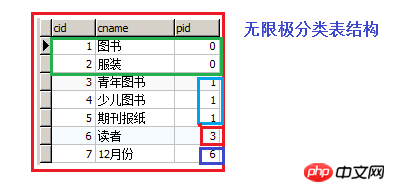A:首先先看下一个简单的面试题
斐波那契数列
规律:1 1 从第三项开始,每一项都是前两项之和
有两种实现方式
第一种方式:
TestSelf((n<0 IllegalArgumentException("n不能为负数" (n<=2 1 TestSelf(n-2)+TestSelf(n-1 30
第二种方式:利用数组
public int TestSelfTwo(int n){ if(n<0){ throw new IllegalArgumentException("n不能为负数");
}else if(n<=1){ //递归前两个数 不管n是多少 为一 return 1;
} int[] nums = new int[n+1]; //30位从零开始 nums[0]=1;
nums[1]=1; for (int i =2;i<n;i++){
nums[i] = nums[i-2]+nums[i-1];
} return nums[n-1];
}
@Test public void Test(){
System.out.println(TestSelfTwo(30));
}
公式:f(n) = f(n-2)+f(n-1) f代表方法 n代表多少 位
B:在MyBatis中利用递归实现n级联动

sql语句:select * from type where pid = 0; 首次指定pid值为0,然后下次根据pid为0的cid 作为下次查询的pid
public List<Category> getCategory(Integer pid); //接口层方法
<mapper namespace="dao.CateGoryDao"><resultMap id="getSelf" type="entity.Category"><id column="cid" property="cid"></id><result column="cname" property="cName"></result><collection property="categorySet" select="getCategory" column="cid"></collection> //这里可以不用指定oftype 使用反向查询select从另一个maper文件中取出数据时必须用ofType<!--查到的cid作为下次的pid--></resultMap><select id="getCategory" resultMap="getSelf" >select * from category where pid=#{pid}</select></mapper>都是指定对象的类型 不同的是当使用反向查询select从另一个maper文件中取出数据时必须用ofType
都可以为collection和association是指定对象的类型,
都不是必须写的, 只有反向select时需要ofType;
实体类:
package entity;import java.util.HashSet;import java.util.Set;/**
* Created by zhangyu on 2017/7/12. */public class Category {private Integer cid;private String cName;private Integer pid;private Set<Category> categorySet = new HashSet<Category>();
@Overridepublic String toString() {return "Category{" +
"cid=" + cid +
", cName='" + cName + '\'' +
", pid=" + pid +
", categorySet=" + categorySet +
'}';
}public Integer getCid() {return cid;
}public void setCid(Integer cid) {this.cid = cid;
}public String getcName() {return cName;
}public void setcName(String cName) {this.cName = cName;
}public Integer getPid() {return pid;
}public void setPid(Integer pid) {this.pid = pid;
}public Set<Category> getCategorySet() {return categorySet;
}public void setCategorySet(Set<Category> categorySet) {this.categorySet = categorySet;
}
}
测试类:
//测试自连接 @Testpublic void TestSelf(){
CateGoryDao dao = MyBatis.getSessionTwo().getMapper(CateGoryDao.class);
List<Category> list = dao.getCategory(0);for (Category item:list ) {
System.out.println(item);
}
}
打印结果:
Category{cid=1, cName='图书', pid=0, categorySet=[Category{cid=5, cName='期刊报纸', pid=1, categorySet=[]}, Category{cid=3, cName='青年图书', pid=1, categorySet=[Category{cid=6, cName='读者', pid=3, categorySet=[Category{cid=7, cName='12月份', pid=6, categorySet=[]}]}]}, Category{cid=4, cName='少儿图书', pid=1, categorySet=[]}]}
Category{cid=2, cName='服装', pid=0, categorySet=[]}
以上是MyBatis自查询并使用递归实现 N级联动的详细内容。更多信息请关注PHP中文网其他相关文章!




